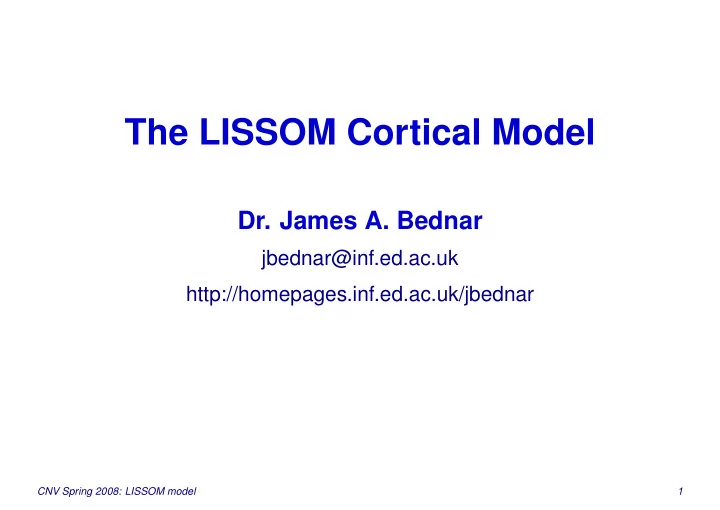

The LISSOM Cortical Model Dr. James A. Bednar jbednar@inf.ed.ac.uk http://homepages.inf.ed.ac.uk/jbednar CNV Spring 2008: LISSOM model 1
Problems with SOMs A Kohonen SOM is very limited as a model of cortical function: • Picking one winner is valid only for a very small patch with very strong lateral inhibition. • Full connectivity is possible only for very small cortical networks. • Lateral interactions are forced to be isotropic, contrary to biological evidence. • Euclidean distance metric is not clearly relatable to neural firing or synaptic plasticity. CNV Spring 2008: LISSOM model 2
Problems with SOM retinotopy The particular model of SOM retinotopy we’ve been looking at also has other problems: • There is no known state when the connections from the eye are evenly distributed across a target region; even the initial connections are retinotopic. • The overall retinotopy is established by axons following gradients of signaling molecules such as Ephrins (reviewed in Flanagan 2006), though activity may have some role in this process (Nicol et al. 2007). In any case, activity appears to be required for map refinement, and it’s interesting that in principle an unfolding process like in the SOM simulation could work. CNV Spring 2008: LISSOM model 3
LISSOM The LISSOM model (Sirosh & Miikkulainen 1994) was designed to remove some of the artificial limitations and biologically unrealistic features of a SOM: • Recurrent lateral interactions, instead of global winner • Specific lateral connections, instead of isotropic neighborhood • Spatially localized RFs, instead of full connectivity • Activation by sigmoided dot product, rather than Euclidean distance • Learning by Hebbian rule CNV Spring 2008: LISSOM model 4
HLISSOM Architecture Higher cortical areas Bednar & Miikkulainen, V1 1995–2004 Preference maps, receptive fields, LGN patchy lateral ON−cells OFF−cells connections, multiple areas, Photoreceptors natural images CNV Spring 2008: LISSOM model 5
HLISSOM Architecture Higher cortical areas Activity: thresholded weighted sum of all V1 receptive fields a w η a = b `P ´ P σ r γ r b X rb w a,rb LGN ON−cells OFF−cells r • Response high when input matches Photoreceptors weights CNV Spring 2008: LISSOM model 6
HLISSOM Architecture Higher cortical areas Learning: normalized Hebbian V1 w a,rb ( t + 1) = a w w a,rb ( t )+ α r η a X rb b P c [ w a,rc ( t )+ α r η a X rc ] LGN • Coactivation → ON−cells OFF−cells strong connection r • Normalization: Photoreceptors distributes strength CNV Spring 2008: LISSOM model 7
Neuron activation function σ ( s ) ( ) σ s CMVC figure 4.5 1.0 0.0 s l u • Piecewise-linear approximation to a sigmoid • Easy to compute • Speeds up computation, since most neurons are truly off • Strongly sensitive to threshold θ l CNV Spring 2008: LISSOM model 8
DoG LGN RFs CMVC figure 4.2 ON neuron OFF neuron • Fixed Difference of Gaussians • Center/surround size ratio based on experimental data • Precisely balanced c/s strength ratio (not quite realistic) CNV Spring 2008: LISSOM model 9
Initial V1 weights CMVC figure 4.3 Afferent (ON and Lateral excitatory Lateral inhibitory OFF) • Initial rough topographic organization • Explicit lateral connections CNV Spring 2008: LISSOM model 10
Self-organized V1 afferent weights CMVC figure 4.6 ON OFF Combined (ON − OFF) Given isotropic Gaussians, learns isotropic Gaussians CNV Spring 2008: LISSOM model 11
Self-organized V1 lateral weights CMVC figure 4.9 Lateral excitatory Lateral inhibitory Combined (exc. − inh.) • Learns isotropic (Mexican-hat) lateral interactions • Reflects the flatness of learned map (no folding) CNV Spring 2008: LISSOM model 12
Self-organized afferent and lateral weights across V1 CMVC figure 4.7 Afferent (ON − OFF) Lateral inhibitory CNV Spring 2008: LISSOM model 13
Self-organization of the retinotopic map CMVC figure 4.8 Initial disordered map Final retinotopic map CNV Spring 2008: LISSOM model 14
Retinotopy input and response CMVC figure 4.4 Retinal LGN Iteration 0: Iteration 0: 10,000: 10,000: activation response Initial V1 Settled V1 Initial V1 Settled V1 response response response response • Settling process: Sharpens activity around strongly activated patches • Multiple winners occur for multiple features on input CNV Spring 2008: LISSOM model 15
Summary LISSOM: same basic process as a SOM, but: • More plausible • More powerful: – Multiple winners – Specific lateral connections • More computation and memory intensive CNV Spring 2008: LISSOM model 16
References Flanagan, J. G. (2006). Neural map specification by gradients. Current Opinion in Neurobiology , 16 , 1–8. Nicol, X., Voyatzis, S., Muzerelle, A., Narboux-Neme, N., Sudhof, T. C., Miles, R., & Gaspar, P . (2007). cAMP oscillations and retinal activ- ity are permissive for ephrin signaling during the establishment of the retinotopic map. Nature Neuroscience . In press. Sirosh, J., & Miikkulainen, R. (1994). Cooperative self-organization of afferent and lateral connections in cortical maps. Biological Cy- bernetics , 71 , 66–78. CNV Spring 2008: LISSOM model 16
Recommend
More recommend